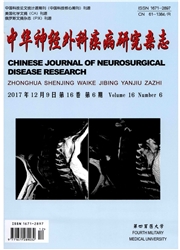

 中文摘要:
中文摘要:
目的探讨黄芪甲苷(AST—IV)和羟基红花黄色素A(HSYA)配伍治疗大鼠脑缺血再灌注损伤作用及其机制。方法100只大鼠随机分为假手术组、模型组、AST—IV组、HSYA组、AST-IV和HSYA配伍组等5组,采用线栓法建立大脑中动脉闭塞(MCAO)模型,再灌注72h评分后处死;脑组织制片后采用苏木素-伊红(HE)染色,免疫组化检测血小板-内皮细胞粘附分子(CD31)表达;氧化炎症检测超氧化物歧化酶(SOD)、丙二醛(MDA)、肿瘤坏死因子-α(TNF-α)、白细胞介素-1β(IL-1β)指标。结果与模型组比较,各给药组均有疗效,AST.IV组、HSYA组、AST.IV和HSYA配伍组均能改善大鼠神经损伤并减轻脑缺血再灌注损伤,促进CD31表达,改善SOD和谷胱甘肽过氧化物酶(GSH—Px)活性,降低TNF-α和IL-β水平,其中配伍组的治疗效果最为显著。结论AST-IV和HSYA配伍可以显著发挥协同抗脑损伤作用,其抗炎、抗氧化和促血管新生作用是潜在作用机制。
 英文摘要:
英文摘要:
Objective The effects and mechanism of astragaloside IV (AST-W) and hydroxysafflor yellow A (HSYA) in combination against cerebral ischemia reperfusion in rats were studied. Methods One hundred Sprague Dawley rats were randomly divided into sham group, model group, AST-IV group, HSYA group and AST-IV + HSYA group. The model of middle cerebral artery occlusion (MCAO) was established by thread ligation. Neurological system symptoms were evaluated at 72 h after ischemia reperfusion. The histopathological changes of brain tissues were stained with hematoxylin and eosin (HE) and the platelet endothelial cell adhesion molecule-1 (CD31) expression was detected via immunohistochemistry. The markers of oxidation and inflammation including superoxide dismutase (SOD), malondialdehyde (MDA), tumor necrosis factor-or (TNF-ct) and interleukin-1β (IL-1β) were examined. Results The symptoms of neurological injury in treatment groups were improved significantly compared with those in model group. The expressiom of CD31 were increased, the activities of SOD and glutathione peroxidase (GSH-Px) were improved, and the levels of TNF-α and IL-1β were decreased. Moreover, the most remarkable effect of treatment occurred in AST-IV and HSYA combination group. Conclusion AST-IV and HSYA in combination can exhibit obvious synergistic protective effects on ischemia reperfusion injury in rats, which is related to anti- inflammation, anti-oxidation and angiogenesis pathway.
 同期刊论文项目
同期刊论文项目
 同项目期刊论文
同项目期刊论文
 期刊信息
期刊信息
